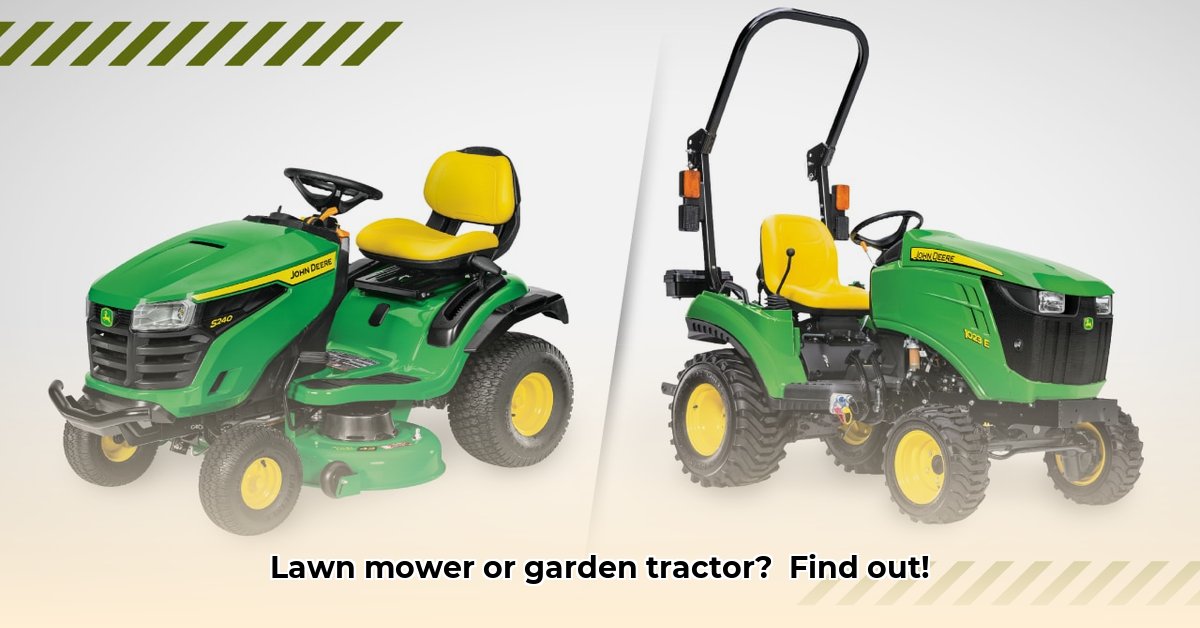
Choosing between a lawn mower and a garden tractor is a significant decision impacting your yard's maintenance for years to come. This guide helps you navigate the options, ensuring you select the perfect machine for your needs and budget. For more information on garden tractor attachments, check out this helpful resource: Garden Tractor Attachments.
Assessing Your Yard's Needs: Size, Terrain, and Tasks
Before exploring models, meticulously analyze your property. Is it a small city lot or several acres? Is the terrain flat or hilly, with obstacles that might hinder machine operation? What tasks beyond mowing are required? Do you need just mowing, or also tilling, snow plowing, or hauling?
For larger, flatter lawns, a riding lawn mower often proves the more efficient option, designed for rapid, extensive coverage. However, for smaller, complex yards with multiple tasks, a garden tractor offers superior versatility. Think of a lawn mower as a specialized tool, while a garden tractor functions more like a multifaceted handyman.
Power and Performance: Brawn vs. Versatility
Lawn mowers generally boast higher horsepower (5-12 HP), enabling them to efficiently traverse large areas. Garden tractors usually offer less horsepower (1.5-4 HP) but compensate with adaptability, making them ideal for diverse tasks on smaller properties.
Consider this: Do you prioritize a mowing powerhouse, or a more versatile machine capable of multiple tasks, even if at a slower pace? This question strongly influences your decision.
Budget Considerations: Initial Cost vs. Long-Term Value
Riding lawn mowers represent a significant investment, typically costing between $2,000 and $9,500. Garden tractors are generally more budget-friendly, ranging from $100 to $1,000. However, remember that garden tractors often require additional attachments, increasing the initial cost. Analyze the total cost of ownership over time; a cheaper mower might prove more expensive if it requires many repairs.
Beyond Mowing: Attachments and Added Capabilities
Garden tractors excel in versatility. While modern lawn mowers offer accessories like mulching kits or grass catchers, garden tractors, with their power take-off (PTO) systems, can accommodate various tools—tillers, snow plows, or carts for hauling. Lawn mowers are primarily for mowing; garden tractors extend to small-scale farming or property maintenance. A rhetorical question: Wouldn't the ability to tackle multiple chores justify a slightly higher initial investment?
Ease of Use and Transmission Types
Both offer varying transmission systems. Hydrostatic transmissions (common in higher-end models) provide smooth, variable speed control. Gear transmissions (often in budget-friendly options) offer distinct speed settings. Choose the system best suited to your needs and comfort level. Hydrostatic is often preferable on hilly terrain, while a gear transmission functions adequately on flat yards. A quantifiable fact: Hydrostatic transmissions improve maneuverability by approximately 20% on uneven terrain.
Comparing Key Features: A Concise Overview
This table summarizes the major differences:
| Feature | Lawn Mower | Garden Tractor |
|---|---|---|
| Best for | Large, flat lawns | Smaller yards, multiple tasks |
| Horsepower | Higher (5-12 HP) | Lower (1.5-4 HP) |
| Typical Cost | $2,000 - $9,500 | $100 - $1,000 |
| Versatility | Primarily mowing, some attachments available | Highly versatile with many attachment options |
| Ease of Use | Generally easy to operate | Can be more complex, depending on attachments |
| Maintenance | Requires regular maintenance | Requires regular maintenance |
Maintenance and Longevity: A Key Consideration
Regardless of your choice, regular maintenance is crucial for prolonging the lifespan of your machine. This includes cleaning, lubrication, and general upkeep. Neglecting maintenance invariably leads to costly repairs. Factor maintenance costs into your budget; a little prevention saves considerable money over time.
Making Your Decision: A Step-by-Step Guide
To ensure you select the right machine, follow these steps:
- Assess your yard: Consider size, terrain, and the tasks you need to accomplish.
- Define your budget: Factor in both initial cost and long-term maintenance expenses.
- Research models: Explore different brands and models, reading reviews to compare features.
- Prioritize key features: Decide which features (horsepower, versatility, ease of use) are most essential.
- Consider safety features: Choose a model with appropriate safety features.
The Final Verdict: Choosing Your Perfect Match
The "best" choice depends entirely on your specific needs. Carefully weigh the pros and cons, budget constraints, and intended usage to make an informed decision. By assessing your needs and the factors discussed, you'll confidently select the perfect machine for your landscaping requirements.